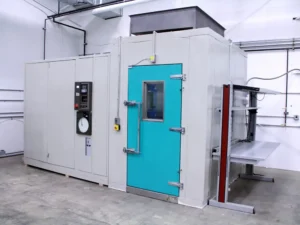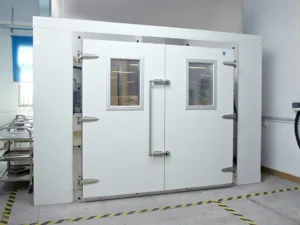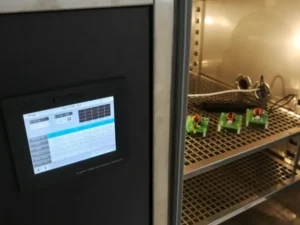Temperature shock vs temperature cycle is a hot topic among many industries. These are the primary testing methods, and their ways of working differ from each other. For manufacturers, testing of the product is vital. It helps them know about the durability and quality of the product.
The thermal shock gives sudden high and low temperatures. It checks the product’s endurance in a very short period. The temperature cycle works in cycles instead of providing sudden temperature changes. It offers more real-life experience to the product and is more reliable.
Such tests help engineers to see how the product will behave when it goes out to the users. The failure in the testing chambers allows the manufacturer to change the product’s material. This guide will highlight the fundamental differences between these two methods. So, let’s jump in!
Overview of Temperature Shock And Temperature Cycle

As I said, the thermal shock method is more towards abruptness. It suddenly provides a very high temperature and then lowers it very low. In this way, the product sees a rapid change in the temperature and acts differently. If the product is durable, it can withstand the change; otherwise, it will malfunction.
The process of the temperature cycle is the opposite. There is no concept of a sudden rise or decrease in temperature. Instead, it provides a different cycle of high and low temperatures. Between cycles, the product gets time to adjust accordingly. In this way, the product faces real-life experience.
Solid and durable products undergo these high/low-temperature cycles without getting affected. If the product fails in the process, the manufacturer can explore the reason for failure. It helps them study and make changes to ensure the product offers durability to the customers. These methods act like beta testing for industries and laboratories.
Working & Mechanism
The temperature shock test works on the principle of expansion and contraction. As you know, when an object is exposed to heat, it contracts. Similarly, on the rapid decrease in temperature, it contracts. For example, the wires in winter and summer contract and expand.
The environmental chambers consist of sensors, motors, and fans. Sensors detect the temperature and allow the users to adjust accordingly. The fans provide follow to the air present inside. The cooler and hotter air fluctuates the temperature. A sudden change in temperature checks the durability of the product.
The temperature cycle is more like thermal fatigue testing. The temperature is provided in steps and cycles. It checks how high or low temperature a material can undergo and how it gets fatigued. During each cycle, the material weeks due to high or low temperature.
It helps to know how good a material is under different conditions. The thermal shocks result in the product cracking and breaking. The reason is that it provides very high and very low temperatures. But the cycle method is smoother and a real-world experience.
Key Differences Between Temperature Shock And Temperature Cycle

Both of these methods serve the same purpose. However, their way of working differs from each other. Both types are extensively used at the industrial and lab levels. I’ll explain the fundamental differences between these two methods in the section below.
1- Speed of Change
In the temperature shock chambers, the speed of change in temperature is very sudden. First, the product is exposed to high temperatures. Once the heat is provided, the chamber suddenly provides a very low temperature. This change from a high to a low temperature happens almost immediately.
It happens very fast, at a speed of at least 30℃/ min. However, the temperature cycle method is different. The high or low temperature is provided in cycles or steps. It heats the product and lets it adjust by taking a short break. The temperature change from high to low happens slowly (less than 10℃/ min).
2- Intensity & Stress
Both methods apply stress by providing a high temperature to the product. However, thermal shock testing offers more abrupt stress by changing the temperature drastically. The stress comes from the temperature changing from hot to cold. A weak product breaks from the stress.
The temperature cycle does not provide crazy stress. Instead, it increases the intensity by giving temperature in cycles. However, this method allows the product to adjust. The consistent heat in short breaks provides more intensity. This allows better checking of the durability and quality of the product.
3- Effect & Causes
The external factor controls the temperature shock method. The chamber abruptly provides exceptionally high and low temperatures. However, the temperature cycle method is more consistent. It works more like the natural environment in which the product will be used.
As far as the effect is concerned, both methods vary. However, they both cause degradation in the product. The temperature shock method provides a sudden and extreme effect. Weak products reach failure mode immediately. However, the impact of the temperature
As you know, it also provides high heat in repetitive manners for a limited duration. So, its effect is more controlled, cumulative, and repeated. It keeps giving temperature until the product reaches the failure mode. It indicates at what temperature the product will start to deteriorate.
4- Repetitive Nature
As I said above, the temperature cycle method is gradual. It repetitively provides heat to ensure a controlled intensity. However, the temperature shock method is the opposite. It forces the change in temperature immediately.
The shock method’s effect is harsher than that of the temperature cycle method. Due to the repetition of cycles, the temperature cycle testing method is more expensive. However, it is more reliable. It gives the exact strengths and weaknesses of the product.
5- Soak Time
The time an object remains under the temperature during the test is known as the soak time. It is different in both methods. It won’t be wrong to say that soak time is irrelevant in the temperature shock test. The reason is that this method is quick.
It changes temperature quickly. So, the soak temperature is very low (ignorable). On the other hand, the temperature cycle has more soak time. It is because this method keeps providing heat in the cycle and takes more time. Hence, the soak time also increases. Better soak time gives more clarity in the testing process.
6- Cost & Affordability
As said earlier, the temperature cycle method works in cycles. So, it requires more energy, heat, and time to complete multiple cycles. The operator will have spent more time doing this test. All this makes the whole process very expensive.
On the other hand, the process of temperature shock is very cost-effective. The reason is that it provides high and low temperatures for once. The object changes temperature. It either bears the change or fails. There are no additional cycles, steps, or energy requirements.
Which One is Effective: Temperature Shock vs Temperature Cycle?
It is hard to judge their effectiveness. The reason is that they both serve their purposes perfectly. Thermal shocks are the winner for quick testing. However, the temperature cycle method is considered reliable and more comprehensive. Thanks to the multiple cycles and steps involved.
It is important to note that the thermal shock method is not realistic. The kind of temperature change it involves is rare in the real world. If a product sustains and tolerates such a significant change, it is of the highest quality. It would make a good name due to its durability. This method offers a very immediate response to the tolerance of materials.
The temperature cycle testing is more reliable. The reason is that it does not force material to face high or low temperatures immediately. Instead, it provides heat in steps and allows the material to adjust. The manufacturer understands how the material will behave under different temperature levels.
Point to Remember: Many industries and laboratories prefer thermal cycle testing. The reason is that this method tells how the product will behave under 100℃, 200℃ and 300℃ temperatures. It won’t be wrong to say that this method is more detailed.
Is Testing in Environmental Chambers Effective for Industries?

Yes, it is very beneficial for both small and big industries. Testing allows the manufacturer to know the characteristics and tolerance of their products. In case of product failure, they can work again to improve it before it goes into the market.
The testing is done in environmental chambers. They offer an environment closer to the real world. Those chambers can easily mimic temperature fluctuations a product undergoes. Such testing is even more crucial for more giant industries with a small margin for error.
The trend of temperature shock and thermal cycle chamber testing is growing. However, the laboratories are more inclined towards the cycle testing method. The reason is that it offers more detailed testing in a real-world environment.
Is Product Failure in the Environmental Chambers Bad for Manufacturers?
It is a myth that the failure of a product in an environmental chamber is bad for the manufacturer. That’s not true. It presents an opportunity if the product fails during temperature shock or cycling. This opportunity allows manufacturers to reassess the materials used in the product.
This way, they can improve products before launching or sending them to the market. As you know, competition in every industry is hot. So, everyone tries to launch products with no fault. So, the testing allows them to analyze the product before its launch. They could fix the issue before the people know it.
It is not always the case that the product will fail. Sometimes, the product can face high-temperature changes successfully. In such a case, the manufacturer can cash in the higher tolerance of the product. They can sell that product with a higher price tag.
Frequently Asked Questions
What is a temperature shock test?
This test is used to check the tolerance and durability of products. In this method, the product is heated to a high temperature. Then, it is cooled immediately. The abrupt change in temperature on the product tells whether it is strong enough or cracks.
What is a temperature cycle test?
It is opposite to temperature shock testing. The heating process is done in cycles or steps instead of suddenness. This test is more reliable and detailed. It gives the product a real-world environmental experience.
What is the purpose of the temperature cycle?
Temperature cycles help determine the durability and strength of the products. The heat applied in cycles tells about the material’s quality. The testing gives an idea of the performance of different heating or cooling levels.
What are the effects of temperature shock on materials or systems?
Temperature shock is very abrupt and degrades the material. The product can break, crack, or deform due to extreme sudden changes in the temperature.
What is the difference between thermal cycling and temperature cycling?
Thermal cycling and temperature cycling are the same things. It is a test used to identify the products’ tolerance and durability.
Conclusion
The usage of different environmental chambers for testing is becoming common. They are considered very useful in analyzing the quality of the products. Although such testing is not cheap, it is still worth it. It saves companies from launching products that are of low quality.
Temperature shock and cycle are both equally important. The first one is quick, and the second testing method is more detailed and reliable. This guide explains the differences between temperature shock and temperature cycle.